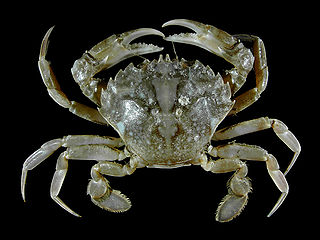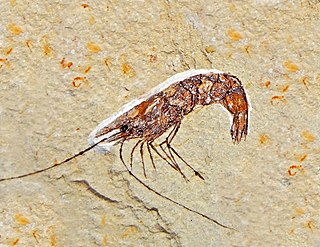
The Glypheoidea, is a group of lobster-like decapod crustaceans which forms an important part of fossil faunas, such as the Solnhofen limestone. These fossils included taxa such as Glyphea, and Mecochirus, mostly with elongated chelipeds. This group of decapods is a good example of a living fossil, or a lazarus taxon, since until their discovery in the 1970s, the group was considered to have become extinct in the Eocene. The superfamily Glypheoidea comprises five families. The two extant species, Neoglyphea inopinata and Laurentaeglyphea neocaledonica, are both in the family Glypheidae.

Eubrachyura is a group of decapod crustaceans comprising the more derived crabs. It is divided into two subsections, based on the position of the genital openings in the two sexes. In the Heterotremata, the openings are on the legs in the males, but on the sternum in females, while in the Thoracotremata, the openings are on the sternum in both sexes. This contrasts with the situation in other decapods, in which the genital openings are always on the legs. Heterotremata is the larger of the two groups, containing the species-rich superfamilies Xanthoidea and Pilumnoidea and all the freshwater crabs. The eubrachyura is well known for actively and constantly building its own burrows. The fossil record of the Eubrachyura extends back to the Cretaceous; the supposed Bathonian representative of the group, Hebertides jurassica, ultimately turned out to be Cenozoic in age.

Corystidae is a family of crabs, in its own superfamily, Corystoidea. It includes what was once thought to be the oldest Eubrachyuran fossil, Hebertides jurassica, thought to be dating from the Bathonian ; the species was subsequently reinterpreted as being Cenozoic in age. Corystidae contains ten extant and five extinct species in eight genera:

Scyllarides is a genus of slipper lobsters.
Cretapenaeus berberus is an extinct species of prawn which existed in Morocco during the Late Cretaceous period. It is the only species in the genus Cretapenaeus.

Macropenaeus is an extinct genus of prawn in the order Decapoda, containing two species: the type species M. incertus, known from the Late Cretaceous (Cenomanian) of Lebanon, and M. sidiaichensis known from the Early Cretaceous (Barremian) of Tunisia.

Palibacus praecursor is a fossil species of slipper lobster, the only species in the genus Palibacus. It was found in Cenomanian (Cretaceous) deposits at Hakel, Lebanon and described in 1886 by the German palaeontologist W. Dames. Its similarity to modern slipper lobsters demonstrates that the main features of that group had already evolved by the mid-Cretaceous.
This list of fossil arthropods described in 2012 is a list of new taxa of trilobites, fossil insects, crustaceans, arachnids and other fossil arthropods of every kind that have been described during the year 2012. The list only includes taxa at the level of genus or species.
This list of fossil arthropods described in 2013 is a list of new taxa of trilobites, fossil insects, crustaceans, arachnids and other fossil arthropods of every kind that have been described during the year 2013. The list only includes taxa at the level of genus or species.
This list of fossil arthropods described in 2014 is a list of new taxa of trilobites, fossil insects, crustaceans, arachnids and other fossil arthropods of every kind that have been described during the year 2014. The list only includes taxa at the level of genus or species.

The Sannine Formation, also called the Sannine Limestone, is a Cretaceous geologic formation in Lebanon. It is a Konservat-Lagerstätte that contains a high diversity of well-preserved fish, reptiles, and invertebrates from the Tethys Ocean within its three main localities: Haqel, Hjoula, and Nammoura.
This list of fossil arthropods described in 2015 is a list of new taxa of trilobites, fossil insects, crustaceans, arachnids and other fossil arthropods of every kind that have been described during the year 2015. The list only includes taxa at the level of genus or species.
This list of fossil arthropods described in 2016 is a list of new taxa of trilobites, fossil insects, crustaceans, arachnids and other fossil arthropods of every kind that have been described during the year 2016, as well as other significant discoveries and events related to arthropod paleontology that occurred in the year 2016.
This list of fossil arthropods described in 2017 is a list of new taxa of trilobites, fossil insects, crustaceans, arachnids and other fossil arthropods of every kind that are scheduled to be described during the year 2017, as well as other significant discoveries and events related to arthropod paleontology that are scheduled to occur in the year 2017.
This list of fossil arthropods described in 2018 is a list of new taxa of trilobites, fossil insects, crustaceans, arachnids, and other fossil arthropods of every kind that were described during the year 2018, as well as other significant discoveries, and events related to arthropod paleontology that are scheduled to occur in the year 2018.
This list of fossil arthropods described in 2019 is a list of new taxa of trilobites, fossil insects, crustaceans, arachnids and other fossil arthropods of every kind that are scheduled to be described during the year 2019, as well as other significant discoveries and events related to arthropod paleontology that are scheduled to occur in the year 2019.

Necrocarcinidae is an extinct family of Late Jurassic and Cretaceous crabs. It comprises 40 species grouped in seven genera.
2020 in arthropod paleontology is a list of new arthropod fossil taxa, including arachnids, crustaceans, insects, trilobites, and other arthropods that were announced or described, as well as other significant arthropod paleontological discoveries and events which occurred in 2020.
2021 in arthropod paleontology is a list of new arthropod fossil taxa, including arachnids, crustaceans, insects, trilobites, and other arthropods that were announced or described, as well as other significant arthropod paleontological discoveries and events which occurred in 2021.
2023 in arthropod paleontology is a list of new arthropod fossil taxa, including arachnids, crustaceans, trilobites, and other arthropods that were announced or described, as well as other significant arthropod paleontological discoveries and events which occurred in 2023.







